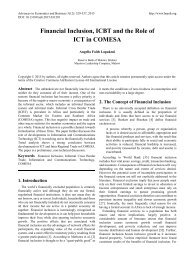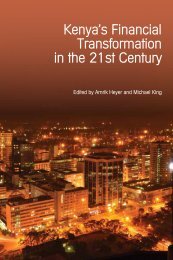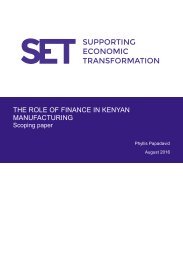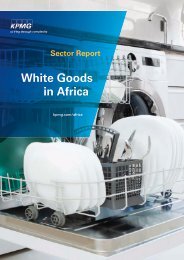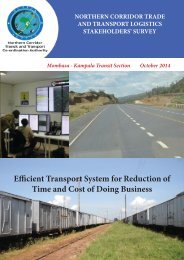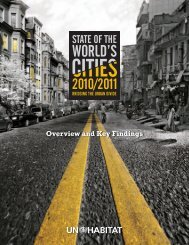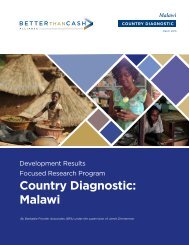FD
gvti301SEaf
gvti301SEaf
Create successful ePaper yourself
Turn your PDF publications into a flip-book with our unique Google optimized e-Paper software.
AFRICA<br />
Economic Community established by the 1991 Abuja Treaty,<br />
which provides the overarching framework for continental<br />
economic integration.<br />
These country groups include the Arab Maghreb Union<br />
and the Community of Sahel-Saharan States in the north, the<br />
Economic Community of West African States (ECOWAS)<br />
in the west, the East African Community (EAC) and the<br />
Intergovernmental Authority on Development in the east, the<br />
Southern African Development Community (SADC) in the<br />
south, the Common Market for Eastern and Southern Africa<br />
(COMESA) in the southeast, and the Economic Community<br />
of Central African States in the center.<br />
The regional economic communities are taking concrete<br />
steps toward integration. For instance, in mobile telecommunications,<br />
they are now applying innovative measures<br />
to reduce the cost of mobile roaming through closer cooperation.<br />
This is particularly true in the EAC. In January 2015,<br />
Kenya, Rwanda, South Sudan, and Uganda launched the East<br />
Africa One Area Network in a bid to harmonize regional calling<br />
rates and lower costs between partner states. Recent estimates<br />
suggest that mobile phone traffic grew by 935 percent<br />
within three months of the launch, while the cost of making<br />
calls fell by over 60 percent.<br />
But critical challenges remain. Formal intra-African trade in<br />
goods is 14 percent, compared with 17 percent for South and<br />
Central America, 42 percent for North America, 62 percent<br />
for the European Union, and 64 percent for Asia. And Africa’s<br />
largest economies still trade on a most-favored-nation basis.<br />
These are just a few examples of how far the continent<br />
has to go before it is truly integrated. While<br />
policymakers have designed integration<br />
frameworks, their implementation has been<br />
hampered by the absence of monitoring and<br />
evaluation mechanisms. Simply put, there<br />
was until recently no means of measuring, in<br />
a precise and objective way, which countries<br />
are making the most progress in deepening<br />
regional integration, in which areas individual<br />
countries are falling behind, and which<br />
policies and institutions have proved most<br />
effective in promoting integration.<br />
Quantifying integration<br />
To fill this gap, the African Union, the African<br />
Development Bank, and the Economic Commission<br />
for Africa have launched the African Regional<br />
Integration Index, which presents a crossborder<br />
and multidimensional view of integration.<br />
The index measures five different dimensions:<br />
trade integration, regional infrastructure,<br />
productive integration, free movement<br />
of people, and financial and macroeconomic<br />
integration. These dimensions build on an<br />
overview of the key socioeconomic factors that<br />
are fundamental to integration. Sixteen categories,<br />
cutting across the five dimensions, are<br />
used to calculate the index (Chart 1).<br />
Lopes, corrected 5/4/16<br />
Trade integration. The free movement of goods is key for<br />
trade growth. Businesses and people benefit when trade flows<br />
are faster and more cost-effective. But in Africa, trade links to<br />
the rest of the world are more direct and efficient than trade<br />
between neighboring regions because of infrastructure gaps<br />
or capital costs and nontariff barriers.<br />
Regional infrastructure. Infrastructure development<br />
across the continent is the most visible face of regional integration.<br />
It includes highways being built across borders,<br />
flights taking passengers from one capital to another, and<br />
more people using mobile phone roaming on city streets<br />
or rural outposts. Countless connections made by road, by<br />
air, or increasingly by airwaves have an important impact<br />
on Africa’s integration efforts. Better regional infrastructure<br />
means lower transaction costs and faster delivery of goods<br />
and services, so regional hubs—as well as small or landlocked<br />
countries—have a lot to gain from promoting infrastructure<br />
to boost economic growth.<br />
Productive integration. Central to Africa’s economic success<br />
is the need to increase production and productivity. Africa<br />
could do more to develop regional and global value chains,<br />
which means fostering more diverse and resilient economic<br />
bases. As consumer purchasing power rises, intermediate<br />
goods that are used by a business in the production of finished<br />
goods or services will be important for Africa’s internal<br />
market. Building industrial clusters goes together with access<br />
to regional trade corridors that get goods moving and with<br />
promoting more regional electricity to power production.<br />
Whether for agriculture or industrial production, regions need<br />
Chart 1<br />
Gauging progress<br />
The African Regional Integration Index measures 16 different indicators across five<br />
broad dimensions.<br />
lnfrastructure Development Index:<br />
transportation, electricity, information<br />
and communication technology,<br />
water and sanitation<br />
•<br />
Proportion of intraregional flights •<br />
Total regional electricity •<br />
trade (net) per capita<br />
Average cost of mobile •<br />
phone roaming<br />
Regional •<br />
convertibility of<br />
national<br />
currencies<br />
Inflation rate •<br />
differential<br />
Proportion of regional economic•<br />
community member countries<br />
whose nationals are issued<br />
a visa on arrival<br />
Regional<br />
infrastructure<br />
Financial and<br />
macroeconomic<br />
integration<br />
Free movement<br />
of people<br />
Level of customs duties<br />
on lmports<br />
•<br />
Share of intraregional goods<br />
• exports<br />
Share of intraregional goods<br />
Trade<br />
integration<br />
•<br />
Ratification (or not)<br />
of regional economic<br />
community protocol on<br />
free movement of people<br />
Productive<br />
integration<br />
• imports<br />
•<br />
Share of total intraregional<br />
goods trade<br />
• Share of intraregional<br />
intermediate goods<br />
exports<br />
• Share of intraregional<br />
intermediate goods<br />
imports<br />
• Merchandise Trade<br />
Complementarity Index<br />
• Proportion of regional economic<br />
community member countries<br />
whose nationals do not require a<br />
visa for entry<br />
Sources: Economic Commission for Africa, African Union Commission, and African Development Bank (2016).<br />
Finance & Development June 2016 19




